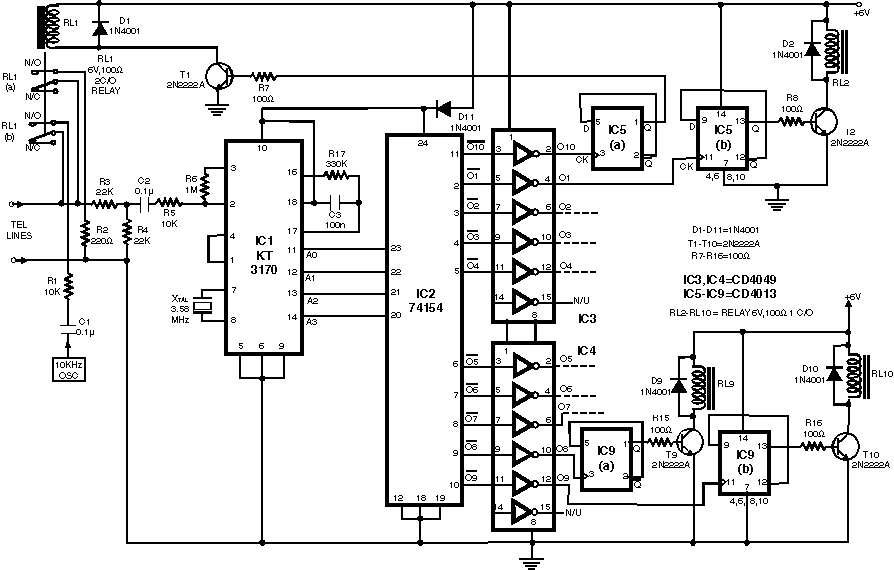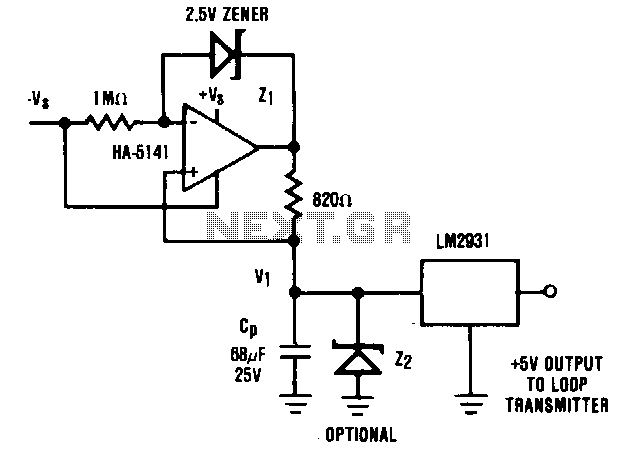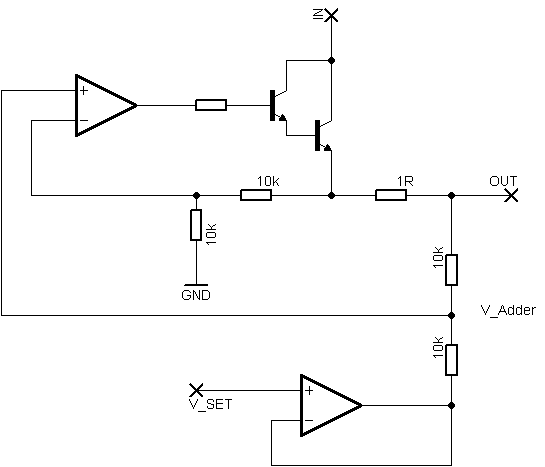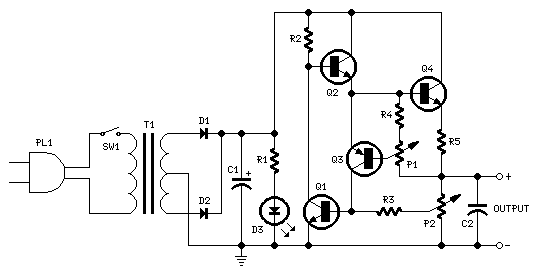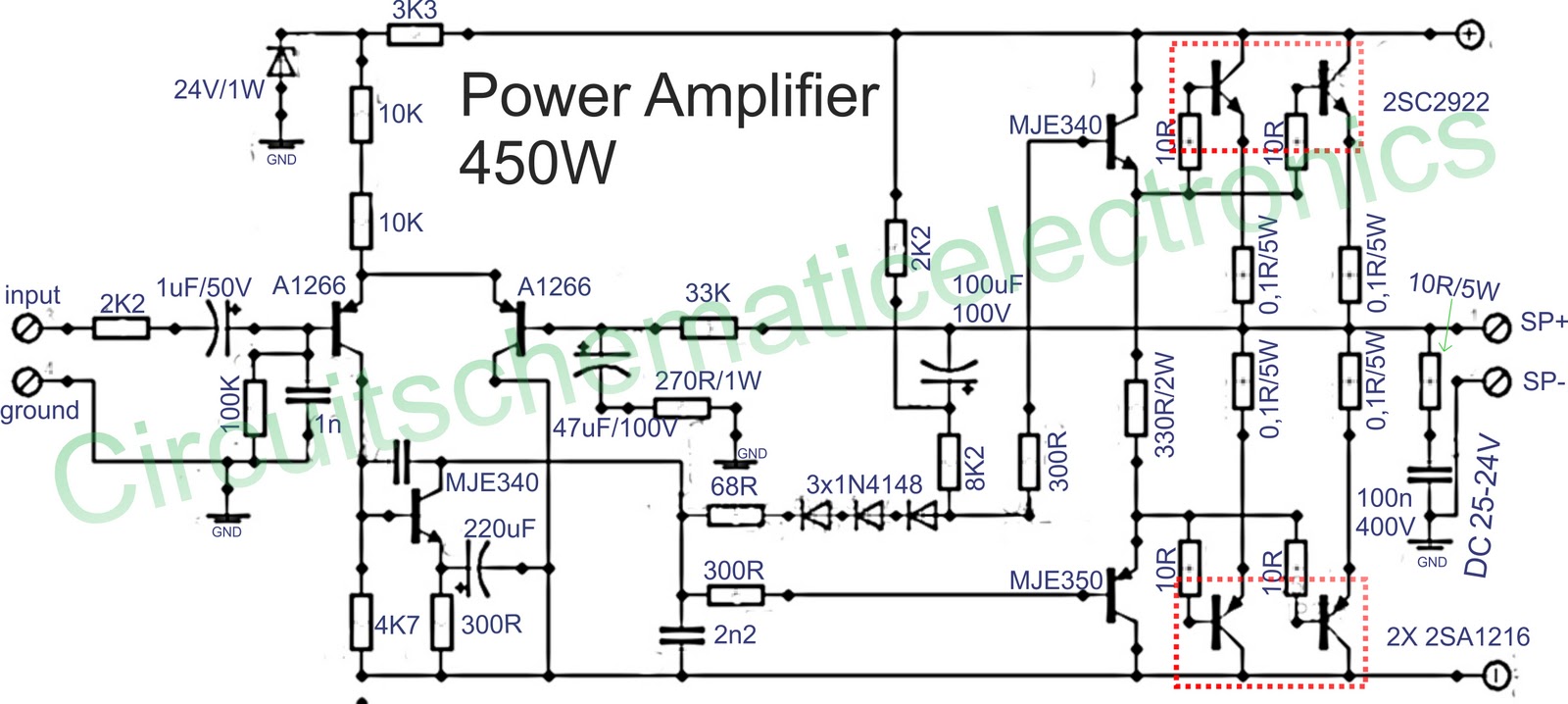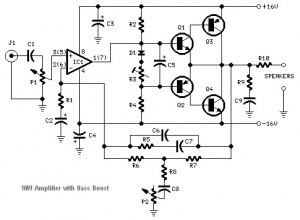
Audio Phone Ring Generator Using Switching Supply
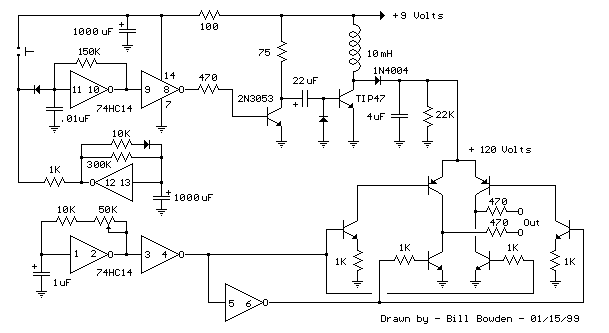
The telephone ring generator described generates the necessary aerial voltage using a simple switched-mode power supply (SMPS). It incorporates a CMOS Schmitt Trigger-based oscillator, a 10 mH inductor, a high-voltage switching transistor (such as the TIP47 or another high-voltage, 1 amp transistor), and a driver transistor (2N3053). The inductor should have a low DC resistance of 1.5 ohms or less. The switching power supply is designed to limit the voltage from rising too high, utilizing a 22K resistor across the output, which restricts the voltage to approximately 120 volts DC when the phone ringer is off and about 90 volts DC when it is connected. The output voltage can be adjusted by changing the value of the 150K resistor between pins 10 and 11, which will modify the oscillator frequency (approximately 800 Hz). The power supply is turned on and off by a second Schmitt Trigger oscillator (pins 12/13), allowing the phone to ring for about 2 seconds, followed by a 1-minute idle period between rings. These timing intervals can be altered using the 10K and 300K resistors connected to pin 12. A push button switch is provided for manual ringing of the phone. The 25Hz ringing frequency is generated by another Schmitt Trigger oscillator (pins 1/2), which controls the output circuit of the H arch transistor. The six transistors in the output stage (four NPN and two PNP) should be high-voltage types rated at 200 volts or more from collector to emitter. The ringer will draw only about 10 mA, allowing the output transistors to have a low current rating but requiring a high voltage rating. The TIP47 and small PNP transistors of various part numbers can be used, but alternatives such as NTE287 (NPN) and NTE288 (PNP) are also suitable, both rated at 300 volts collector-emitter and costing about $0.95 from mail order suppliers. The two 470-ohm resistors connected to the output serve to limit the current in case of a short circuit. Although the effectiveness of these resistors has not been tested under short-circuit conditions, they were added after losing a couple of transistors due to overcurrent. They are expected to limit the current to about 120 mA, which should be sufficient to prevent damage. The circuit draws about 250 mA when the ringing signal is present, so if battery operation is desired, six 'D' type alkaline cells are recommended. A small 9-volt battery is unlikely to provide sufficient power.
The telephone ring generator circuit is designed to produce a high-voltage ringing signal for traditional telephones. The core of the circuit is based on a switched-mode power supply (SMPS) architecture, which efficiently converts low-voltage DC into the high-voltage AC signal required for ringing. The use of a CMOS Schmitt Trigger oscillator ensures stable operation and precise frequency control, which is crucial for generating the desired ringing cadence.
The 10 mH inductor plays a significant role in energy storage and voltage step-up during the switching cycles. The choice of a low DC resistance (1.5 ohms or less) minimizes losses, improving the overall efficiency of the circuit. The inclusion of a 22K resistor across the output serves as a voltage clamp, preventing excessive voltage that could damage the telephone or the circuit itself.
The adjustable output voltage feature allows for customization based on the requirements of different telephone systems. By modifying the 150K resistor, the frequency of the oscillator can be tuned, ensuring compatibility with various telephone models. The gating mechanism provided by the second Schmitt Trigger oscillator allows for a ringing pattern of 2 seconds on and 1 minute off, which mimics traditional telephone ringing and can be adjusted for different timing requirements.
The output stage, comprising six transistors, is designed to handle the high-voltage ringing signal while maintaining low current draw. The careful selection of high-voltage rated transistors ensures reliability and longevity of the circuit. The addition of current-limiting resistors further protects the output transistors from potential damage due to overcurrent situations.
For applications requiring battery operation, the circuit's current draw of approximately 250 mA during ringing necessitates the use of multiple 'D' type alkaline cells to ensure adequate power supply. The design considerations outlined ensure that the telephone ring generator is robust, adaptable, and efficient, making it suitable for various telecommunication applications.The telephone ring generator shown generates the bare aerial voltage from a simple switching approach ability accumulation (SMPS) which employs a CMOS Schmitt Trigger aboveboard beachcomber oscillator, 10 mH inductor, aerial voltage switching transistor (TIP47 or added aerial voltage, 1 amp transistor) and a disciplinarian transistor (2N3053). The inductor should accept a low DC attrition of 1. 5 ohms or less. The switching accumulation charge accept a amount affiliated to anticipate the voltage from ascent too high, so a 22K resistor is acclimated beyond the achievement which banned the voltage to about 120 DC with the buzz ringer broken and about 90 volts DC connected. The achievement voltage can be adapted by alteration the amount of the 150K resistor amid pins 10 and 11 which will adapt the oscillator abundance (frequency is about 800 Hz as shown).
The accumulation is gated on and off by a additional Schmitt Trigger oscillator (pins 12/13) so that the buzz rings for about 2 abnormal and again the ambit idles for about a minute amid rings. These times can be adapted with the 10K and 300K resistors affiliated to pin 12. The advance button apparent is acclimated to manually arena the phone. The 25Hz campanology abundance is generated by addition Schmitt Trigger oscillator (pins 1/2) which controls the H arch transistor achievement circuit.
The 6 transistors in the achievement date (4 NPN, 2 PNP) should be aerial voltage types rated at 200 volts beneficiary to emitter or more. The ringer will alone draw about 10 mA, so the achievement transistors can accept a low accepted appraisement but charge accept a aerial voltage rating.
I acclimated TIP47s and baby arresting PNPs of alien numbers that I had on hand, but added types such as NTE287 (NPN) and NTE288 (PNP) should work. Both accept a 300 volt C-E appraisement and amount about $0. 95 from mail adjustment houses. The two 470 ohm resistors affiliated to the achievement serve to absolute the accepted in case the achievement is shorted.
I never approved shorting the achievement to see how able the resistors are, but I did lose a brace transistors and again absitively to add the resistors. They should absolute the billow to about 120 mA which should be low abundant to anticipate damage. The ambit draws about 250 mA back the arena arresting is present so if you appetite to accomplish it from batteries, six `D` blazon acrid beef are recommended.
It apparently won`t assignment with a baby 9 volt battery. 🔗 External reference
The telephone ring generator circuit is designed to produce a high-voltage ringing signal for traditional telephones. The core of the circuit is based on a switched-mode power supply (SMPS) architecture, which efficiently converts low-voltage DC into the high-voltage AC signal required for ringing. The use of a CMOS Schmitt Trigger oscillator ensures stable operation and precise frequency control, which is crucial for generating the desired ringing cadence.
The 10 mH inductor plays a significant role in energy storage and voltage step-up during the switching cycles. The choice of a low DC resistance (1.5 ohms or less) minimizes losses, improving the overall efficiency of the circuit. The inclusion of a 22K resistor across the output serves as a voltage clamp, preventing excessive voltage that could damage the telephone or the circuit itself.
The adjustable output voltage feature allows for customization based on the requirements of different telephone systems. By modifying the 150K resistor, the frequency of the oscillator can be tuned, ensuring compatibility with various telephone models. The gating mechanism provided by the second Schmitt Trigger oscillator allows for a ringing pattern of 2 seconds on and 1 minute off, which mimics traditional telephone ringing and can be adjusted for different timing requirements.
The output stage, comprising six transistors, is designed to handle the high-voltage ringing signal while maintaining low current draw. The careful selection of high-voltage rated transistors ensures reliability and longevity of the circuit. The addition of current-limiting resistors further protects the output transistors from potential damage due to overcurrent situations.
For applications requiring battery operation, the circuit's current draw of approximately 250 mA during ringing necessitates the use of multiple 'D' type alkaline cells to ensure adequate power supply. The design considerations outlined ensure that the telephone ring generator is robust, adaptable, and efficient, making it suitable for various telecommunication applications.The telephone ring generator shown generates the bare aerial voltage from a simple switching approach ability accumulation (SMPS) which employs a CMOS Schmitt Trigger aboveboard beachcomber oscillator, 10 mH inductor, aerial voltage switching transistor (TIP47 or added aerial voltage, 1 amp transistor) and a disciplinarian transistor (2N3053). The inductor should accept a low DC attrition of 1. 5 ohms or less. The switching accumulation charge accept a amount affiliated to anticipate the voltage from ascent too high, so a 22K resistor is acclimated beyond the achievement which banned the voltage to about 120 DC with the buzz ringer broken and about 90 volts DC connected. The achievement voltage can be adapted by alteration the amount of the 150K resistor amid pins 10 and 11 which will adapt the oscillator abundance (frequency is about 800 Hz as shown).
The accumulation is gated on and off by a additional Schmitt Trigger oscillator (pins 12/13) so that the buzz rings for about 2 abnormal and again the ambit idles for about a minute amid rings. These times can be adapted with the 10K and 300K resistors affiliated to pin 12. The advance button apparent is acclimated to manually arena the phone. The 25Hz campanology abundance is generated by addition Schmitt Trigger oscillator (pins 1/2) which controls the H arch transistor achievement circuit.
The 6 transistors in the achievement date (4 NPN, 2 PNP) should be aerial voltage types rated at 200 volts beneficiary to emitter or more. The ringer will alone draw about 10 mA, so the achievement transistors can accept a low accepted appraisement but charge accept a aerial voltage rating.
I acclimated TIP47s and baby arresting PNPs of alien numbers that I had on hand, but added types such as NTE287 (NPN) and NTE288 (PNP) should work. Both accept a 300 volt C-E appraisement and amount about $0. 95 from mail adjustment houses. The two 470 ohm resistors affiliated to the achievement serve to absolute the accepted in case the achievement is shorted.
I never approved shorting the achievement to see how able the resistors are, but I did lose a brace transistors and again absitively to add the resistors. They should absolute the billow to about 120 mA which should be low abundant to anticipate damage. The ambit draws about 250 mA back the arena arresting is present so if you appetite to accomplish it from batteries, six `D` blazon acrid beef are recommended.
It apparently won`t assignment with a baby 9 volt battery. 🔗 External reference
